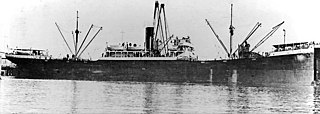
The first USS Woolsey (DD-77) was a Wickes-class destroyer in the United States Navy during World War I. She was named for Melancthon Taylor Woolsey.

USS Victoria (AO-46) was an oiler for the United States Navy in World War II, and the second ship to bear the name. She was built in 1917 as SS George G. Henry in San Francisco for the Los Angeles Petroleum Company. During World War I, the ship was requisitioned by the U.S. Navy and employed as USS George G. Henry (ID-1560). Between the two world wars and at the beginning of the second, she served as a civilian tanker, initially under American registry, but later under Panamanian registry.

USS Aeolus (ID-3005), sometimes also spelled Æolus, was a United States Navy transport ship during World War I. She was formerly the North German Lloyd liner SS Grosser Kurfürst, also spelled Großer Kurfürst, launched in 1899 that sailed regularly between Bremen and New York. At the outset of World War I the ship was interned by the United States and, when the U.S. entered the conflict in 1917, was seized and converted to a troop transport.

USS West Carnifax (ID-3812) was a cargo ship in the United States Navy shortly after World War I. After she was decommissioned from the Navy, the ship was known as SS West Carnifax, SS Exford, and SS Pan Royal in civilian service under American registry.

SS Zaanland was a cargo steamship that was built in Scotland in 1900 for Dutch owners, and sunk in a collision in 1918. She was built for the Zuid-Amerika Lijn, which in 1908 became Koninklijke Hollandsche Lloyd. The US Government requisitioned her in March 1918 as USS Zaanland, with the Naval Registry Identification Number ID–2746. She was sunk in a collision less than two months later.

USS Munalbro was a cargo ship that served in the United States Navy from 1918 to 1919.

The second USS Wachusett (ID-1840) was a cargo ship that served in the United States Navy from 1918 to 1919.

USS Jeannette Skinner (ID-1321), sometimes spelled incorrectly as USS Jeanette Skinner, was a cargo ship that served in the United States Navy from 1918 to 1919.

USS Texan (ID-1354) was a United States Navy cargo ship and troop transport in commission from 1918 to 1919.

The first USS Los Angeles (ID-1470) was a tanker that served in the United States Navy from 1917 to 1919.

USS Kermanshah (ID-1473) was a cargo ship that served in the United States Navy from 1918 to 1919.

USS Alaskan (ID-4542) was a United States Navy cargo ship and troop transport in commission from 1918 to 1919.

USS Walter D. Munson (ID-1510) was a United States Navy cargo ship in commission from 1918 to 1919.
Sylvan Arrow was a steam tanker built in 1917–1918 by New York Shipbuilding Co. of Camden for Standard Oil Company, with intention of transporting oil and petroleum products between United States and ports in the Far East. The ship was briefly requisitioned by the US Government during World War I but returned to commercial service in early 1919.

USS Standard Arrow (ID-1532) was a United States Navy tanker in commission from 1917 to 1919. She was built as SS Standard Arrow for the Standard Oil Company. In World War II, she was again acquired by the U.S. Navy from Standard Oil and commissioned as USS Signal (IX-142) a station tanker in the Pacific from 1944 to 1946.

SS West Gotomska was a steel–hulled cargo ship built in 1918 as part of the World War I emergency wartime shipbuilding program organized by the United States Shipping Board.

USS Montclair (ID-3497) was a United States Navy refrigerated cargo ship in commission from 1918 to 1919.
USS West Mead (ID-3548), also spelled Westmead, was a United States Navy cargo ship in commission from 1918 to 1919.

Western Maid was a 5,760 GRT cargo ship that was built in 1918 by the Northwest Steel Company, Portland, Oregon, USA. She was built for the United States Shipping Board (USSB), but was commissioned into the United States Navy on completion as USS Western Maid, with the pennant number ID-3703. In 1919 she was decommissioned and returned to the USSB. In 1937 she was passed to the United States Maritime Commission. In 1940 she was transferred to the British Ministry of Shipping and renamed Empire Cormorant, passing to the Ministry of War Transport (MoWT) in 1941. In 1945 she was scuttled in the North Atlantic with a cargo of obsolete war matériel.

USS Westerner (ID-2890) was a cargo ship of the United States Navy that served during World War I and its immediate aftermath.



















